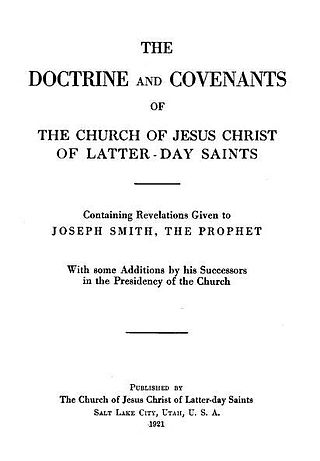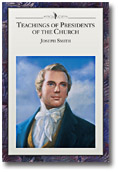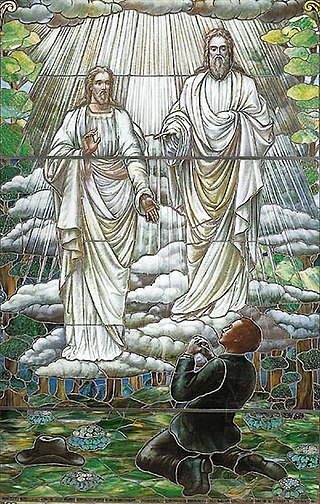
The Standard Works of the Church of Jesus Christ of Latter-day Saints are the four books that currently constitute its open scriptural canon. The four books of the standard works are:

The Doctrine and Covenants is a part of the open scriptural canon of several denominations of the Latter Day Saint movement. Originally published in 1835 as Doctrine and Covenants of the Church of the Latter Day Saints: Carefully Selected from the Revelations of God, editions of the book continue to be printed mainly by the Church of Jesus Christ of Latter-day Saints and the Community of Christ.

Community of Christ, known from 1872 to 2001 as the Reorganized Church of Jesus Christ of Latter Day Saints (RLDS), is an American-based international church, and is the second-largest denomination in the Latter Day Saint movement. The church reports approximately 250,000 members in 1,100 congregations in 59 countries. The church traces its origins to Joseph Smith's establishment of the Church of Christ on April 6, 1830. His eldest son Joseph Smith III formally accepted leadership of the church on April 6, 1860 in the aftermath of the 1844 death of Joseph Smith.

The Joseph Smith Translation (JST), also called the Inspired Version of the Holy Scriptures (IV), is a revision of the Bible by Joseph Smith, the founder of the Latter Day Saint movement, who said that the JST/IV was intended to restore what he described as "many important points touching the salvation of men, [that] had been taken from the Bible, or lost before it was compiled". Smith was killed before he deemed it complete, though most of his work on it was performed about a decade beforehand. The work is the King James Version of the Bible (KJV) with some significant additions and revisions. It is considered a sacred text and is part of the canon of Community of Christ (CoC), formerly the Reorganized Church of Jesus Christ of Latter Day Saints, and other Latter Day Saint churches. Selections from the Joseph Smith Translation are also included in the footnotes and the appendix of the Latter-day Saint edition of the LDS-published King James Version of the Bible. The Church of Jesus Christ of Latter-day Saints' edition of the Bible includes selections from the JST in its footnotes and appendix. It has officially canonized only certain excerpts that appear in the Pearl of Great Price. These excerpts are the Book of Moses and Smith's revision of part of the Gospel of Matthew.
The Primary is the children's organization of the Church of Jesus Christ of Latter-day Saints. It acts as a Sunday school organization for the church's children.
In the Church of Jesus Christ of Latter-day Saints, the Priesthood Correlation Program began in 1908 as a program to reform the instruction manuals and curriculum of the different organizations of the church. Its scope quickly widened, and Correlation came to affect almost every aspect of the church, including doctrines, organizations, finances, and ordinances. A significant consequence was to centralize decision-making power in the priesthood, particularly the Quorum of the 12 Apostles. More recently, the function of the correlation department has shifted to planning and approving church publications and curriculum and keeping unorthodox information, doctrines, and other undesired concepts from being introduced or revived.

Missionaries of The Church of Jesus Christ of Latter-day Saints —widely known as Mormon missionaries—are volunteer representatives of the church who engage variously in proselytizing, church service, humanitarian aid, and community service. Missionaries of the LDS Church may be male or female and may serve on a full- or part-time basis, depending on the assignment. Missionaries are organized geographically into missions, which could be any one of the 449 missions organized worldwide. This is one of the practices that the LDS Church is well-known for.

Within the Latter Day Saint movement, the "Articles of Faith" is a statement of beliefs composed by Joseph Smith as part of an 1842 letter sent to "Long" John Wentworth, editor of the Chicago Democrat, and first published in the Latter Day Saint newspaper Times and Seasons. It is a concise listing of thirteen fundamental doctrines of Mormonism. Most Latter Day Saint denominations view the articles as an authoritative statement of basic theology. Some denominations, such as the Church of Jesus Christ of Latter-day Saints, have adopted the articles as scripture. For some sects, the Articles of Faith are known collectively as "An Epitome of Faith and Doctrine".

The Pearl of Great Price is part of the canonical Standard Works of the Church of Jesus Christ of Latter-day Saints and some other Latter Day Saint denominations.
Jesus the Christ: A Study of the Messiah and His Mission According to the Holy Scriptures Both Ancient and Modern is a 1915 book by James E. Talmage. The book is a doctrinal study on the life and ministry of Jesus Christ and is widely appreciated by members of the Church of Jesus Christ of Latter-day Saints. The book consists of 42 chapters, each focusing on important aspects of the life and mission of Jesus as the Messiah.

Community of Christ and the Church of Jesus Christ of Latter-day Saints are two denominations that share a common heritage in the Church of Christ founded by Joseph Smith on April 6, 1830. Since Smith's death in 1844, they have evolved separately in belief and practices. The Church of Jesus Christ of Latter Day Saints is headquartered in Salt Lake City, Utah, and claims more than 17 million members worldwide; Community of Christ is headquartered in Independence, Missouri, and reports a worldwide membership of approximately 250,000.
Worship services of the Church of Jesus Christ of Latter-day Saints include weekly services held in meetinghouses on Sundays in geographically based religious units. Once per month, this weekly service is a fast and testimony meeting. Twice each year, the LDS Church holds a worldwide general conference. LDS Church adherents also worship in temples, which are open only to members in good standing.

Teachings of Presidents of the Church is a series of books published by the Church of Jesus Christ of Latter-day Saints. Each book of the series briefly compiles the teachings and sermons of one of the men who has served as president of the LDS Church. The text of each book is not limited to sermons preached while the person was president of the church, but generally contain teachings given during their time as an ordained apostle.
In the Church of Jesus Christ of Latter-day Saints, the priesthood is the power and authority to act in the name of God for the salvation of humankind. Male members of the church who meet standards of worthy behavior and church participation are generally ordained to specific offices within the priesthood.
Sunday School is an organization of the Church of Jesus Christ of Latter-day Saints. All members of the church and any interested nonmembers, age 11 and older, are encouraged to participate in Sunday School.

In the Latter Day Saint movement, baptism is recognized as the first of several ordinances (rituals) of the gospel.

The General Handbook: Serving in The Church of Jesus Christ of Latter-day Saints is an on-line book of instructions and policies for leaders and members of the Church of Jesus Christ of Latter-day Saints. The contents are prepared by the church's First Presidency and Quorum of the Twelve Apostles. Along with the church's standard works, the General Handbook stands as the preeminent policy and practice guide for the leaders of the LDS Church.
The Church of Jesus Christ of Latter-day Saints has been subject to criticism and sometimes discrimination since its inception.

The Church of Jesus Christ of Latter-day Saints focuses its doctrine and teaching on Jesus Christ; that he was the Son of God, born of Mary, lived a perfect life, performed miracles, bled from every pore in the Garden of Gethsemane, died on the cross, rose on the third day, appeared again to his disciples, and now resides, authoritatively, on the right hand side of God. In brief, some beliefs are in common with Catholics, Orthodox and Protestant traditions. However, teachings of the LDS Church differ significantly in other ways and encompass a broad set of doctrines, so that the above-mentioned denominations usually place the LDS Church outside the bounds of orthodox Christian teaching as summarized in the Nicene Creed.
Exaltation is a belief in Mormonism that after death some people will reach the highest level of salvation in the celestial kingdom and eternally live in God's presence, continue as families, become gods, create worlds, and make spirit children over whom they will govern. In the largest Mormon denomination, the Church of Jesus Christ of Latter-day Saints, top leaders have taught that God wants exaltation for all humankind and that humans are "gods in embryo". A verse in the LDS Church's canonized scripture states that those who are exalted will become gods, and a 1925 statement from the church's highest governing body said that "All men and women are in the similitude of the universal Father and Mother ... [and are] capable, by experience through ages and aeons, of evolving into a God."











